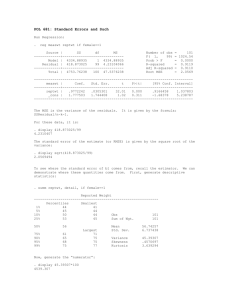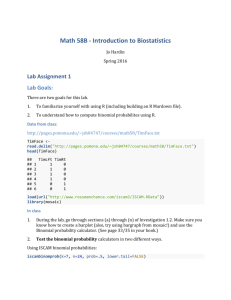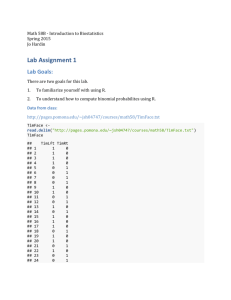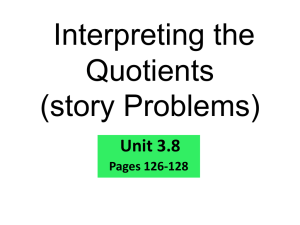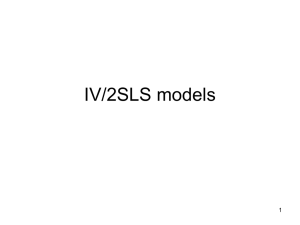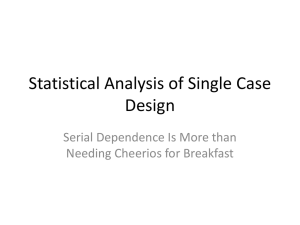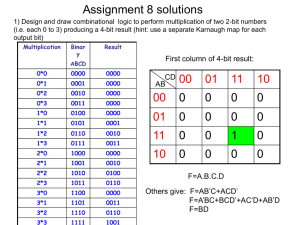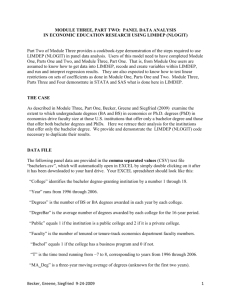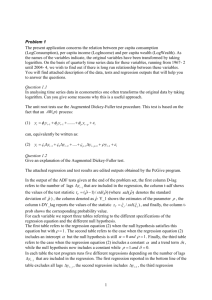Part1-Methodology - NYU Stern
advertisement
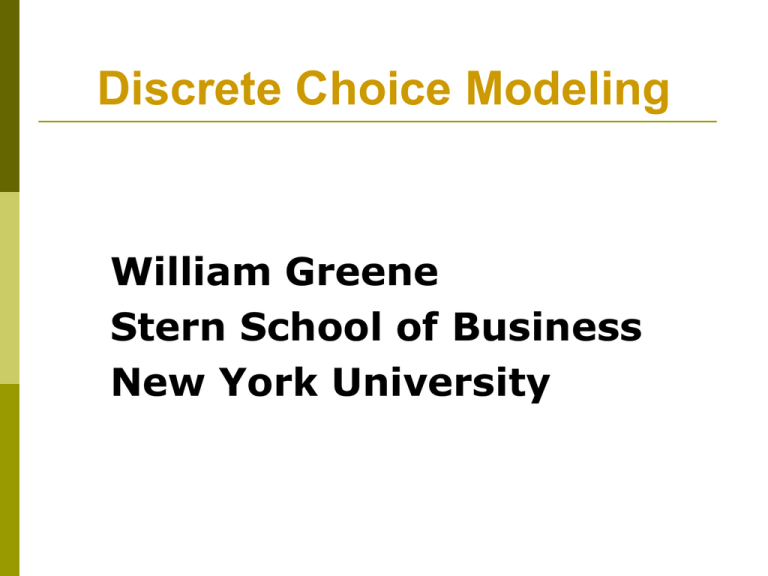
Discrete Choice Modeling William Greene Stern School of Business New York University Part 1 Introduction Modeling Categorical Variables Theoretical foundations Econometric methodology Models Statistical bases Econometric methods Applications Discrete Choice Modeling Econometric Methodology Regression Basics Discrete Choice Models for Categorical Data Binary Choice Models Ordered and Bi-/Multivariate Choice Models for Count Data Multinomial Choice Models Model Building Specification Estimation Analysis and Hypothesis Testing Applications Course Objectives Theory: Theoretical underpinnings of the models Models and data generating mechanisms Econometric Theory Practice Tools for estimation and inference Model specification Analysis and interpretation of numerical results The Sample and Measurement Population Theory Measurement Characteristics Behavior Patterns Choices Inference Population Measurement Econometrics Characteristics Behavior Patterns Choices Classical Inference Population Measurement Econometrics Imprecise inference about the entire population – sampling theory and asymptotics Characteristics Behavior Patterns Choices Bayesian Inference Population Measurement Econometrics Sharp, ‘exact’ inference about only the sample – the ‘posterior’ density. Characteristics Behavior Patterns Choices Issues in Model Building Estimation Coefficients Interesting Partial Effects Functional Form and Specification Statistical Inference Prediction Individuals Aggregates Model Assessment and Evaluation Regression Basics The “MODEL” = conditional mean function Modeling the mean Modeling probabilities for discrete choice Specification Estimation – coefficients and partial effects Hypothesis testing Prediction… and Fit Estimation Methods Econometric Frameworks Nonparametric Semiparametric Parametric Classical (Sampling Theory) Bayesian We will focus on classical inference methods Application: Health Care Usage German Health Care Usage Data, 7,293 Individuals, Varying Numbers of Periods Variables in the file are Data downloaded from Journal of Applied Econometrics Archive. This is an unbalanced panel with 7,293 individuals. They can be used for regression, count models, binary choice, ordered choice, and bivariate binary choice. This is a large data set. There are altogether 27,326 observations. The number of observations ranges from 1 to 7. (Frequencies are: 1=1525, 2=2158, 3=825, 4=926, 5=1051, 6=1000, 7=987). Note, the variable NUMOBS below tells how many observations there are for each person. This variable is repeated in each row of the data for the person. (Downloaded from the JAE Archive) DOCTOR = 1(Number of doctor visits > 0) HOSPITAL = 1(Number of hospital visits > 0) HSAT = health satisfaction, coded 0 (low) - 10 (high) DOCVIS = number of doctor visits in last three months HOSPVIS = number of hospital visits in last calendar year PUBLIC = insured in public health insurance = 1; otherwise = 0 ADDON = insured by add-on insurance = 1; otherswise = 0 HHNINC = household nominal monthly net income in German marks / 10000. (4 observations with income=0 were dropped) HHKIDS = children under age 16 in the household = 1; otherwise = 0 EDUC = years of schooling AGE = age in years MARRIED = marital status EDUC = years of education Household Income Regression - Income ---------------------------------------------------------------------Ordinary least squares regression ............ LHS=LOGINC Mean = -.92882 Standard deviation = .47948 Number of observs. = 887 Model size Parameters = 2 Degrees of freedom = 885 Residuals Sum of squares = 183.19359 Standard error of e = .45497 Fit R-squared = .10064 Adjusted R-squared = .09962 Model test F[ 1, 885] (prob) = 99.0(.0000) Diagnostic Log likelihood = -559.06527 Restricted(b=0) = -606.10609 Chi-sq [ 1] (prob) = 94.1(.0000) Info criter. LogAmemiya Prd. Crt. = -1.57279 Akaike Info. Criter. = -1.57279 Bayes Info. Criter. = -1.56200 --------+------------------------------------------------------------Variable| Coefficient Standard Error b/St.Er. P[|Z|>z] Mean of X --------+------------------------------------------------------------Constant| -1.71604*** .08057 -21.299 .0000 EDUC| .07176*** .00721 9.951 .0000 10.9707 --------+------------------------------------------------------------Note: ***, **, * = Significance at 1%, 5%, 10% level. ---------------------------------------------------------------------- Specification and Functional Form ---------------------------------------------------------------------Ordinary least squares regression ............ LHS=LOGINC Mean = -.92882 Standard deviation = .47948 Number of observs. = 887 Model size Parameters = 3 Degrees of freedom = 884 Residuals Sum of squares = 183.00347 Standard error of e = .45499 Fit R-squared = .10157 Adjusted R-squared = .09954 Model test F[ 2, 884] (prob) = 50.0(.0000) Diagnostic Log likelihood = -558.60477 Restricted(b=0) = -606.10609 Chi-sq [ 2] (prob) = 95.0(.0000) Info criter. LogAmemiya Prd. Crt. = -1.57158 Akaike Info. Criter. = -1.57158 Bayes Info. Criter. = -1.55538 --------+------------------------------------------------------------Variable| Coefficient Standard Error b/St.Er. P[|Z|>z] Mean of X --------+------------------------------------------------------------Constant| -1.68303*** .08763 -19.207 .0000 EDUC| .06993*** .00746 9.375 .0000 10.9707 FEMALE| -.03065 .03199 -.958 .3379 .42277 --------+------------------------------------------------------------- Interesting Partial Effects ---------------------------------------------------------------------Ordinary least squares regression ............ LHS=LOGINC Mean = -.92882 Standard deviation = .47948 Number of observs. = 887 Model size Parameters = 5 Degrees of freedom = 882 Residuals Sum of squares = 171.87964 Standard error of e = .44145 Fit R-squared = .15618 Adjusted R-squared = .15235 Model test F[ 4, 882] (prob) = 40.8(.0000) Diagnostic Log likelihood = -530.79258 Restricted(b=0) = -606.10609 Chi-sq [ 4] (prob) = 150.6(.0000) Info criter. LogAmemiya Prd. Crt. = -1.62978 E [ Incom e | x ] Akaike Info. Criter. = -1.62978 A ge Bayes Info. Criter. = -1.60279 A ge --------+------------------------------------------------------------Variable| Coefficient Standard Error b/St.Er. P[|Z|>z] Mean of X --------+------------------------------------------------------------Constant| -5.26676*** .56499 -9.322 .0000 EDUC| .06469*** .00730 8.860 .0000 10.9707 FEMALE| -.03683 .03134 -1.175 .2399 .42277 AGE| .15567*** .02297 6.777 .0000 50.4780 AGE*AGE| -.00161*** .00023 -7.014 .0000 2620.79 --------+------------------------------------------------------------- 2 A ge A ge 2 Partial Effects Impact of Age on Simulated Income Inference: Does the same model apply to men and women? Modeling Approaches Nonparametric – “relationship” Semiparametric – usually “index function;” x Minimal Assumptions Minimal Conclusions Somewhat stronger assumptions Robust to model misspecification (heteroscedasticity) Still weak conclusions Parametric – “Probability function and index” Strongest assumptions – complete specification Strongest conclusions Possibly less robust. Nonparametric Regression for log Income Nonparametric Regressions for a Binary Outcome (Visit Doctor) P(Visit)=f(Age) P(Visit)=f(Income) Semiparametric Approaches The current standard: Klein and Spady: Find b to maximize a semiparametric likelihood of G(b’x) Klein and Spady Semiparametric Note necessary normalizations. Coefficients are not meaningful. Prob(yi = 1 | xi ) = G(β̒x) G is estimated by kernel methods Fully Parametric Index Function: U* = β’x + ε Observation Mechanism: y = 1[U* > 0] Distribution: ε ~ f(ε); Normal, Logistic, … Maximum Likelihood Estimation: Max(β) logL = Σi log Prob(Yi = yi|xi) Modeling Approaches The contemporary social science literature is overwhelmingly dominated by parametric models for categorical variables We will focus on parametric models from this point on. Categorical Variables Observed outcomes Inherently discrete: number of occurrences, e.g., family size Implicitly continuous: The observed data are discrete by construction, e.g., revealed preferences; our main subject Multinomial: The observed outcome indexes a set of unordered labeled choices. Implications For model building For analysis and prediction of behavior Binary Outcome Self Reported Health Satisfaction Count of Occurrences Multinomial Unordered Choice Heterogeneity and Endogeneity How to model panel data Take advantage of richness of the data Appropriately accommodate unobserved heterogeneity (with fixed effects, random effects, other models) How to handle endogeneity Omitted effects Structural models of simultaneous causality Frameworks Discrete Outcomes Binary Choices Ordered Choices Models for Counts Multinomial Choice Modeling Methods Modeling the conditional mean Modeling Probabilities
